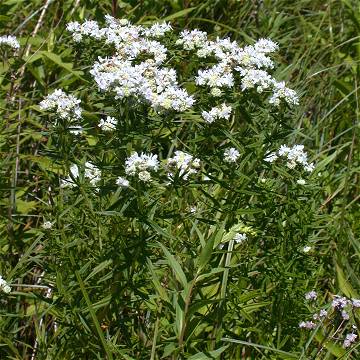

Pycnanthemum virginianum - (image 1 of 7)
Taxonomy
Family: Lamiaceae
Habitat
Unshaded grassy native communities. Dry to moist prairies. Calcareous fens.
Associates
In calcareous fens with Aster novae-angliae, Equisetum arvense, Eupatorium perfoliatum, Liatris spicata, Lycopus americanus, Lysimachia quadriflora, Lythrum alatum, Oxypolis rigidior, Pedicularis lanceolata, Solidago ohioensis.
Distribution
ME west to ND, south GA to OK
Morphology
Erect herbaceous perennial to 3' high. Leaves opposite, simple, entire, lanceolate, acute, more than 3 times longer than wide. Stems pubescent along the angles, glabrous to glabrate along the faces, 4-sided. Flowers white to purple (spotted?), 4 or more in cymes terminating the stems and branches; calyx tubular, the lobes shorter than the tube and less than 1 mm long; outermost foliaceous bracts glabrous on the adaxial face.
Notes
Flowers mid June to early October
Wetland indicator: Facultative Wetland +
The aromatic mountain mints can be used to make tea.
* T. Durand & B. D. Jacks.
References
Gleason, Henry A. and A. Cronquist. 1991. Manual of Vascular Plants of Northeastern United States and Adjacent Canada. Second Ed.
The New York Botanical Garden. Bronx, NY.
Peterson, L. A. 1977. A Field Guide to Edible Wild Plants: Eastern and central
North America
Houghton Mifflin Company. New York, NY
Swink, F. and G. Wilhelm. 1994. Plants of the Chicago Region.
Indiana Academy of Science. The Morton Arboretum. Lisle, Illinois.
|
Michael Hough © 2005 |